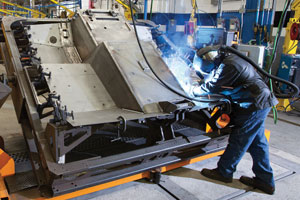Durable Goods Orders Rise for First Time in Three Months

Orders for durable goods rose in January for the first time in three months, showing manufacturing may be starting to stabilize as companies look beyond weaker global markets and cutbacks among energy producers.
Bookings for goods meant to last at least three years increased 2.8% after a revised 3.7% decrease the prior month, data from the Commerce Department showed Feb. 26 in Washington. Non-military capital goods orders excluding aircraft rose 0.6% after a 0.7% decrease in December.
Business demand rose for equipment including machinery and computers, indicating domestic sales are underpinning manufacturing. At the same time, orders have been held back as factories contend with tepid sales to overseas customers and a slump in oil prices prompts producers to limit investment.
“With these kinds of broad-based job gains, it seems like a lot of sectors are contributing and that’s generally a good sign for all sorts of spending, including cap-ex,” Joseph LaVorgna, chief U.S. economist at Deutsche Bank Securities Inc. in New York, said before the report. “We’d be doing better if global growth was stronger.”
The median forecast of 82 economists surveyed by Bloomberg News estimated durable goods orders would rise 1.6%, with projections ranging from a 4.5% drop to a 4% increase.
Excluding transportation equipment, which is often volatile from month to month, bookings increased 0.3%. Demand for non-defense goods rose 3% after a 3.3% drop.
Commercial aircraft orders jumped 128.5% in January after slumping 58.3% a month earlier.
Boeing Co., the Chicago-based aerospace company, said it received five orders for planes last month, the weakest tally since January 2013 and down from 174 the prior month. Industry data doesn’t always correlate with the government statistics on a month-to-month basis.
Shipments of non-military capital goods excluding aircraft, used in calculating gross domestic product, dropped 0.3% last month after rising 0.3% in December.
Business equipment spending in the fourth quarter fell at a 1.9% annualized rate, the biggest decline since April-June 2009, according to the Commerce Department’s first estimate of GDP for the period.

